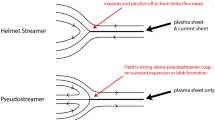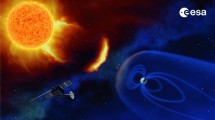Abstract
The National Solar Observatory/Kitt Peak synoptic rotation maps of the magnetic field and of the equivalent width of the He i 1083 nm line are used to identify and measure polar coronal holes from September 1989 to the present. This period covers the entire lifetime of the northern and southern polar holes present during cycles 22 and 23 and includes the disappearance of the previous southern polar coronal hole in 1990 and and formation of the new northern polar hole in 2001. From this sample of polar hole observations, we found that polar coronal holes evolve from high-latitude (∼ 60° ) isolated holes. The isolated pre-polar holes form in the follower of the remnants of old active region fields just before the polar magnetic fields complete their reversal during the maximum phase of a cycle, and expand to cover the poles within 3 solar rotations after the reversal of the polar fields. During the initial 1.2–1.4 years, the polar holes are asymmetric about the pole and frequently have lobes extending into the active region latitudes. During this period, the area and magnetic flux of the polar holes increase rapidly. The surface areas, and in one case the net magnetic flux, reach an initial brief maximum within a few months. Following this initial phase, the areas (and in one case magnetic flux) decrease and then increase more slowly reaching their maxima during the cycle minimum. Over much of the lifetime of the measured polar holes, the area of the southern polar hole was smaller than the northern hole and had a significantly higher magnetic flux density. Both polar holes had essentially the same amount of magnetic flux at the time of cycle minimum. The decline in area and magnetic flux begins with the first new cycle regions with the holes disappearing about 1.1–1.8 years before the polar fields complete their reversal. The lifetime of the two polar coronal holes observed in their entirety during cycles 22 and 23 was 8.7 years for the northern polar hole and 8.3 years for the southern polar hole.
Similar content being viewed by others
References
Andretta, V. and Jones, H. P.: 1997, Astrophys. J. 489, 375.
Bohlin, J. D.: 1977, Solar Phys. 51, 377.
Bohlin, J. D. and Sheeley, N. R., Jr.: 1978, Solar Phys. 56, 125.
Bravo, S. and Steward, G. A.: 1994, Solar Phys. 154, 377.
Bravo, S., Steward, G. A., and Blanco-Cano, X.: 1998, Solar Phys. 179, 223.
Broussard, R. M., Sheeley, N. R., Jr., Tousey, R., and Underwood, J. H.: 1978, Solar Phys. 56, 161.
Durrant, C. J., Kress, J. M., and Wilson, P. R.: 2001, Solar Phys. 201, 57.
Fox, P., McIntosh, P., and Wilson, P. R: 1998, Solar Phys. 177, 375.
Goldberg, L.: 1939, Astrophys. J. 89, 673.
Harvey, K. L.: 1996, in 'Proceedings of the Eighth International Solar Wind Conference', AIP Conference Proceedings 382,9.
Maravilla, D., Lara, A., Valdés-Galicia, J. F., and Mendoza, B.: 2001, Solar Phys. 203, 27.
Makarov, V. V., Tlatov, A. G., and Sivaraman, K. R.: 2001, Solar Phys. 202, 11.
Obridko, V. N. and Shelting, B. D.: 1999, Solar Phys. 187, 185.
Sanchez-Ibarra, A. and Barraza-Paredes, M.: 1992, Report UAG-102, WDCA, Boulder, Colorado.
Sheeley, N. R., Jr.: 1980, Solar Phys. 65, 229.
Sheeley, N. R., Jr., DeVore, C. R., and Boris, J. B.: 1985, Solar Phys. 98, 219.
Sheeley, N. R., Jr., Wang, Y.-M., and DeVore, C. R.: 1989, Solar Phys. 124, 1.
Sheeley, N. R., Jr., Wang, Y.-M., and Harvey, J. W.: 1989, Solar Phys. 119, 323.
Simpson, J. A., Zhang, M., and Bame, S.: 1996, Astrophys. J. 465, L29.
Smith, E. J., Jokipii, J. R., Kó ta, J., Lepping, R. P., and Szabo, A.: 2000, Astrophys. J. 533, 1084.
Smith, E. J., Balogh, A., Forsyth, R. J., and McComas, D. J.: 2001, Geophys. Res. Let. 28, 4159.
Snodgrass, H. B., Kress, M. J., and Wilson, P. R.: 2000, Solar Phys. 191, 1.
Waldmeier, M.: 1957, Die Sonnenkorona, Vol. II, Birckhauser, Basel, p. 65.
Waldmeier, M.: 1981, Solar Phys. 70, 251.
Wang, Y.-M. and Sheeley, N. R., Jr.: 1996, Astrophys. J. 447, L143.
Wang, Y.-M., Hawley, S. H., and Sheeley, N. R., Jr.: 1996, Science 271, 464.
Webb, D. F., Davis, J. M., and McIntosh, P. S.: 1984, Solar Phys. 92, 109.
Zirin, H.: 1988, Astrophysics of the Sun, Cambridge University Press, Cambridge, p. 198.
Zirker, J. B.: 1977, Coronal Holes and High Speed Wind Streams, Colorado Associated University Press, Boulder.
Author information
Authors and Affiliations
Rights and permissions
About this article
Cite this article
Harvey, K.L., Recely, F. Polar Coronal Holes During Cycles 22 and 23. Solar Physics 211, 31–52 (2002). https://doi.org/10.1023/A:1022469023581
Issue Date:
DOI: https://doi.org/10.1023/A:1022469023581




